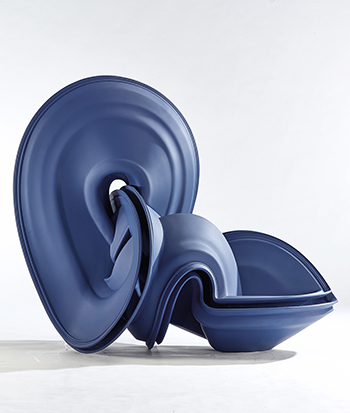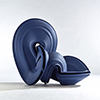EXHIBITED:
Tony Cragg , Marian Goodman Gallery, New York, May 3 - June 9, 2007
Tony Cragg in 4D , CA’PESARO - International Gallery of Modern Art, Venice, Feburary 5 - May 28, 2011
Tony Cragg: Sculptures and Drawings , Scottish National Gallery of Modern Art, Edinburgh, July 30 - November 6, 2011
Tony Cragg: Sculptures and Drawings , Art Museum of CAFA, Beijing, March 2 - April 15, 2012
Tony Cragg: Sculptures and Drawings , National Taiwan Museum of Fine Arts, Taichung, January 12 - March 24, 2013
Tony Cragg , Benaki Museum, Athens, September 8 - November 8, 2015
Tony Cragg / Wim Delvoye , Art Taipei 2015 - Nou Gallery, Taipei, October 30 - November 2, 2015
Tony Cragg: Primary Colors , Dutko Gallery & Holtermann Fine Art, London, March 1 - April 13, 2017
ILLUSTRATED:
Jed Morse, Tony Cragg: Seeing Things Exhibition
Catalogue , Nasher Sculpture Center, U.S.A., 2011, color illustrated, no. 44
Tony Cragg: Sculptures and Drawings , National Taiwan Museum of Fine Arts, Taichung, 2013, color illustrated, cover page
Tony Cragg / Wim Delvoye , Nou Gallery, Taipei, 2015, color illustrated
This sculpture is to be sold with a certificate of authenticity issued by Leisure Art Center, Taipei.
Catalogue Note:
“SCULPTURES ARE SOMETHING VERY EXCEPTIONAL, IT’S NOT PRACTICAL, THEY ARE NOT MEANT TO BE SAT ON … IT EXPANDS OUR IMAGINATION, MATERIAL IS WHAT GIVES US LANGUAGE, IT IS THE FOUNDATION OF LANGUAGE.”
-TONY CRAGG
The critically acclaimed British sculptor Tony Cragg was born in Liverpool in 1949, and has moved to Germany in 1977, where he currently lives and works. Cragg has participated the influential exhibition of Documenta in Kassel Germany in 1982 and 1987, and was later awarded with the Turner Prize by Tate in 1988. In that same year, Cragg represented Britain to attend the 43rd Venice Biennale. Seen as the successor of the modern sculptor Henry Moore, Cragg went on to hold a solo exhibition at the Louvre in 2011. Ever since Cragg began studying at the Royal College of Art, he has been exploring the possibilities of material and the connection between the intrinsic qualities of different materials. How materials trigger further insights and perceptions, these are the questions that Cragg has been trying to explore. Given the advancement of technology and change of times, new techniques have aided Cragg new aspects and skills in experimenting new creations with diverse range of medium. Since 1970, we have been able to witness progressive breakthroughs and continuous growth in Cragg’s works in almost every five years. From his early days of assembling whatever he had at hand, to the ‘90s when he slowly began to extend and contort his materials. Cragg continued to challenge the possibilities of space using concepts of interconnectivity, juxtaposition, stacking and twisting to arrange his objects into all sorts of irregular shapes.
The internationally prominent sculptor was once exhibited at the National Taiwan Museum of Fine Arts back in 2013 for the length of three months. The particular work of “McCormack” was also featured in the solo exhibition. In Cragg's works, it is not difficult to spot forms and structures in relations to mechanical components; one can also detect the silhouettes of human facial features from various irregular angles. Searching for such subtle details hidden in his works offers viewers a sense of the delight and excitement, as to those moments when children feel thrilled when they spotted recognizable shapes from the clouds in the sky. Cragg’s past experiences are also directly or indirectly exhibited in his works. For example, in his earlier works in the 1970s, he assembled many discarded plastic products he had collected, and turned them into colorful shapes of human figurations, Cragg established a unique artistic vocabulary of his own. The work made from plastics also invites the question about the environmental impact people have brought about to the society. The artist once said that: “In the late 60s and 70s, I wasn’t really interested in sculpting something, copying something, I was interested in what I could do with material, and how material affected me, and I think that is really what sculpture is.”
In an era of mass production, Cragg sought to explore the possibilities of materials and experiment with various materials. It is possible that the past experience of working part-time as a research assistant at a rubber research center, as well as at the mold casting factory gave birth to his experimental spirit, and prompted him to frequently draw inspiration from industrial mechanical tools. Some of these seemingly abstract and irregular sculptures were in part conceived through computer calculations, in order achieve such precision in their presentation. Although Cragg has the help of several assistants to work on his sculptures, the artist still insists on seeing through his creations from start to finish; from making the sketches to casting original mold by hand.“McCormack” is dedicated to one of his important technical assistants, Mike McCormack, who has worked alongside the artist for well over twenty years. Without the technical support of Mike, they may not be able to overcome the technical difficulties in finalizing the final work.
The way artist sees it, people tend to focus on the superficial layer or only have better sense of understanding objects with functional value. For example, a marble table would just be a “table” to most, whereas Cragg sees it as an appreciation of the force of nature. As the texture of marble itself was the cause of tens of thousands of years of heat and pressure. It is what lies beneath the surface that he finds worth exploring in his sculptures. “Sculptures are something very exceptional, it’s not practical, they are not meant to be sat on … it expands our imagination, material is what gives us language, it is the foundation of language” says Cragg. Indeed, aren’t those magnificent formations of stalactites we encountered in the nature exceptional, as it takes up to a hundred years to grow just one centimeter high? Likewise, if one is able to spend some extra time in the observation of Cragg’s works, one may realize that even though many of them are man-made objects, they respond to nature all the time like organisms. Although they may appear static, they retain a sense of dynamic as they alter with the shifting of time and continuous cycle of life. It is especially seen on Cragg’s large scale mirror finished outdoor stainless steel sculptures, as they are reflective of the sights surrounding them.
Today, Cragg’s works are to be seen in major museums worldwide, besides the three branches of Tate Musem, Tate Britain and Tate Modern, his works are also in the collection of Museum of Contemporary Art, Chicago; 21st century museum kanazawa in Japan; Ekebergparken and Museet for samtidskunst - Nasjonalmuseet in Oslo, Norway; Museo Nacional Centro de Arte, Reina Sofia, Madrid, Spain; National Gallery of Canada; Daegu Art Museum, Korea etc. Cragg’s works is also widely exhibited around the world, his works are currently exhibited at the Sanati Contemporary Arts Museum, Kerman in Iran until July 2018, Other major solo shows have include the State Hermitage Museum, St Petersburg, Russia (2016), Benaki Museum, Athens, Greece (2015), Heydar Aliyev Centre, Baku, Azerbaijan (2014), CAFA Museum in Beijing, China (2012).



